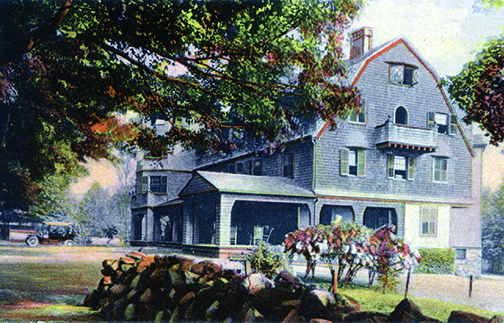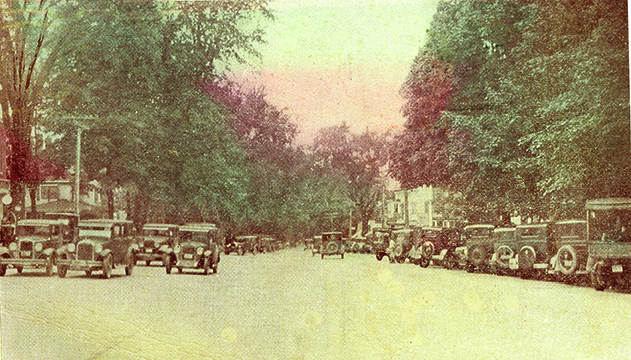 “Ridgefield’s face is her fortune,” people used to say years ago. They were probably thinking of Main Street, that magnificent mixture of homesteads with history, religion, art, and commerce that has been the town’s heart — as well as its face — for three centuries.
“Ridgefield’s face is her fortune,” people used to say years ago. They were probably thinking of Main Street, that magnificent mixture of homesteads with history, religion, art, and commerce that has been the town’s heart — as well as its face — for three centuries.
Originally called the “Town Street,” Main Street was created around 1708 when 25 home lots of just over seven acres were laid out on each side by the pioneer families. The road stretches a mile and a half along the middle of three ridges near what was then the geographical center of land purchased from the American Indians that year.
On Dec. 26, 1721, the town fathers officially defined the road as “eight rodds weadth” or 132 feet wide, about twice the width of 18th Century highways. Most of that, now right-of-way owned by the state, is greensward that over the centuries has supported stately lines of leafy trees.
Back in the early 1700s, however, trees along the Town Street weren’t considered an embellishment but a harvestable resource, providing lumber for building the settlers’ houses and feeding their fireplaces. Trees also blocked sunlight needed for vegetable gardens and orchards. Probably only after the town became well-settled after 1750 did the luxury of ornamental trees begin appearing in the village.
By the 1850s native-son Samuel Griswold Goodrich, author of the “Peter Parley” books, was telling his brother, “The street, on the whole, is one of the most beautiful I know of. It is more than a mile in length… ornamented with two continuous lines of trees – elms, sycamores, and sugar-maples… Some of these, in front of the more imposing houses, are truly majestic.”
The Main Street’s earliest “hub” extended from around West Lane north to King Lane, lined with not only the famous Keeler Tavern, but shops, a factory, and village artisans, such as blacksmiths and harness makers, as well as the town’s primary gathering place on the “village green.” The Meeting House served as the Congregational Church and the town hall in the 18th Century. Much of the green on which it stood, called the Meeting House Yard, is now the front lawn of the Jesse Lee Methodist Church. Nearby on the green was the village schoolhouse.
The commercial center gradually moved northerly to where it is today, encouraged by the 1870 arrival of the railroad branch and anchored in 1876 with the first real town hall.
That town hall was built of wood, a fact that doomed it less than two decades later when the Great Fire of 1895 broke out in the Bedient building (now home of Books on the Common) and leveled more than a block of commercial buildings, a devastating blow to a community that had been growing in population and popularity.
The arrival of the railroad spur at Prospect Street meant one could travel from Manhattan to Ridgefield in just over two hours. That drew many New Yorkers seeking country homes in the clean, brisk air of Ridgefield’s hills, nearly 800 feet above sea level. Many created fancy estates (some of which were described in the previous 068 issue). Tourism grew and inns sprouted up all along Main Street, from The Elms at the north end to the Ridgefield Inn at the south.
The New Yorkers were mostly a boon but sometimes a bane. As Ridgefielders well know, the village was the site in 1777 of the main engagement of the Battle of Ridgefield, when patriots barricaded northern Main Street against British troops marching to Long Island Sound after burning Danbury. One of the most historic relics of that battle was the Benjamin Stebbins house, a 1727 saltbox that was not only bullet-scarred by the battle, but also served as a hospital for the wounded. A New York man tore it down to build his mansion, Casagmo, on the site that is now the condominium community.
Mostly, however, the city folk were saviors. In the wake of the 1895 fire, they paid for the creation of a water supply system with hydrants along much of Main Street. They also helped establish the Ridgefield Fire Department, which marked its 125th birthday in 2022, and bankrolled the building of a new town hall — of fire-proof brick — with space for a firehouse in the basement. The same New Yorkers would pay for much of the cost of Ridgefield’s first modern school on East Ridge (also of brick).
New York businessmen owned several sizable estates established along Main Street; two have become popular town parks. Graeloe, once the home of Revolutionary Col. Philip Burr Bradley and later the retreat of Dr. Daniel Adams, called the “father of baseball,” was embellished by Lucius Biglow, a music publisher whose daughter wound up giving the land to the town. Today it’s Ballard Park.
Veterans Park was the home of Phineas Lounsbury who, though born here, made his fortune in Manhattan and retired to Ridgefield — and politics: He was elected Connecticut governor in 1887. He amassed a fine estate, much of which the town purchased in 1945. Today his stately mansion is the Ridgefield Community Center, also called Lounsbury House.
 Ridgefielders have been careful to preserve their town’s face, establishing in 1965 a historic district along the street to the south of the business center. While no such district exists to the north, efforts have been made to protect its streetscape, such as setting Casagmo buildings 300 feet back from the road. When The Elms Inn complex was converted to townhouses, the native owners preserved the 1760 inn building and its 19th Century annex. Even the modern Ridgefield Library has retained — and, indeed, treasures — its original 1902
Ridgefielders have been careful to preserve their town’s face, establishing in 1965 a historic district along the street to the south of the business center. While no such district exists to the north, efforts have been made to protect its streetscape, such as setting Casagmo buildings 300 feet back from the road. When The Elms Inn complex was converted to townhouses, the native owners preserved the 1760 inn building and its 19th Century annex. Even the modern Ridgefield Library has retained — and, indeed, treasures — its original 1902
brick quarters.
Long after the railroad left the village, Main Street remains a destination for visitors from New York and beyond. All are welcomed by the Cass Gilbert Fountain and three miles of sidewalks from which they may view and visit historic sites, two museums, several galleries, as well as many shops and restaurants.
Ridgefield is growing, but its face is still glowing. •